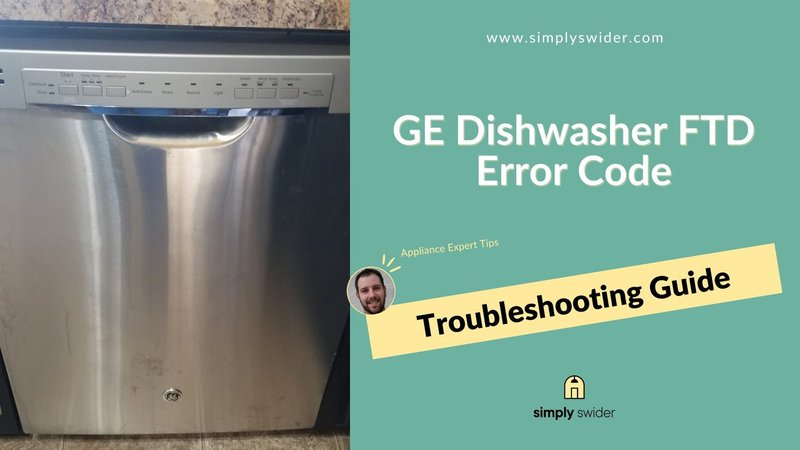
Here’s the thing: Error codes are your dishwasher’s way of telling you something’s not quite right. The “LE” code is specifically related to a potential leak. While it might be tempting to turn a blind eye and carry on with life, ignoring this signal can lead to bigger issues down the road. Think of it like ignoring the check engine light in your car – sure, you might get away with it for a while, but sooner or later, it could result in a costly repair. So let’s dive deeper into what this code means and what you should do about it.
Understanding the GE Dishwasher Error Code LE
When your GE dishwasher displays the “LE” error code, it’s essentially waving a red flag about a potential leak detection issue. This code is part of the appliance’s safety mechanism designed to prevent water damage in your kitchen. You see, dishwashers are thoughtful machines that want to save you from the hassle of cleaning up water everywhere. So, when they suspect a leak, they let you know right away.
The most common cause of the “LE” code is a water leak inside the dishwasher itself. It’s like the dishwasher employs a little detective that senses if water is spilling where it shouldn’t be. Now, this can happen due to several reasons: a faulty door gasket, a loose hose, or even a more significant internal component failure. If you think about it, it’s similar to finding a small leak in a garden hose – ignoring it might mean you’ll be facing a sudden burst of water all over your yard.
Once this code appears, your dishwasher might stop mid-cycle to prevent further leakage. This interruption is a protective measure, ensuring no water seeps out onto your kitchen floor. It’s the machine’s way of saying, “Hey, there’s something wrong here, and we need to fix it before continuing.” So, it’s not just a mere suggestion; it’s a call to action.
Consequences of Ignoring the Error Code
Now, you might be thinking, “What if I just reset the dishwasher and pretend I didn’t see anything?” It’s a valid thought, but here’s where things get tricky. Continuously ignoring the “LE” error code can lead to more severe damage. Just like ignoring a small crack in your windshield might result in it shattering completely, a small leak can grow, causing significant water damage, mold growth, and even electrical issues.
Imagine coming home to a kitchen floor soaked in water because the tiny leak you dismissed decided to make a grand entrance. That’s not a scene anyone wants to face. Additionally, water damage can lead to costly repairs, not just for the dishwasher but for your entire kitchen floor or cabinetry, depending on where the water travels.
Furthermore, ignoring this error might void your dishwasher’s warranty. Manufacturers include terms that require addressing error codes promptly as part of maintaining their appliances. So, taking a moment to address the issue can save you more than just the cost of repairs—it can prevent potential warranty headaches.
Steps to Fix the GE Dishwasher Error Code LE
So, what should you do if you see that “LE” error code mocking you from the display panel? First and foremost, don’t panic. Addressing this issue doesn’t always mean calling in a professional right away. Begin by inspecting the dishwasher door. Over time, the door gasket can wear out or become dislodged. Think of it like the seal on a jar—if it’s not tight, liquid can escape. Press down on the gasket and ensure it’s correctly seated.
Next, check the hoses connected to the dishwasher. A loose or cracked hose can easily cause leaks. It might be as simple as tightening a connection or replacing a worn-out hose, much like you would do with a garden hose that’s seen better days. Often, these small adjustments can resolve the LE error without much fuss.
If these steps don’t solve the problem, it might be time to consult the dishwasher’s manual for any specific instructions related to the “LE” error code. Keep in mind that these manuals are like your dishwasher’s personal diary, filled with useful tips and troubleshooting advice. And if all else fails, reaching out to a professional technician can ensure the problem is diagnosed and fixed correctly, saving you from future worries.
Preventing Future Error Codes
Prevention is key, and a little maintenance goes a long way in keeping your GE dishwasher happy and error-free. Regularly inspecting your dishwasher for signs of wear and tear can prevent most problems before they start. It’s akin to regularly changing the oil in your car—a small task that ensures the smooth running of your appliance.
Consider running a cycle with a dishwasher cleaner monthly. This simple step removes any build-up inside the machine, much like a detox for your dishwasher. It keeps the internal components functioning correctly and reduces the chance of blockages or leaks.
Lastly, don’t overload your dishwasher. While it might be tempting to cram every last dish into one cycle, overloading can cause stress on the machine and might lead to premature wear on components. Give your dishwasher some breathing room, and it will serve you well for years to come.
In conclusion, while it might be convenient to ignore the “LE” error code and hope it disappears, addressing the issue head-on can save you time, money, and a lot of headaches. With regular maintenance and a little TLC, your GE dishwasher will continue to be a reliable kitchen companion.